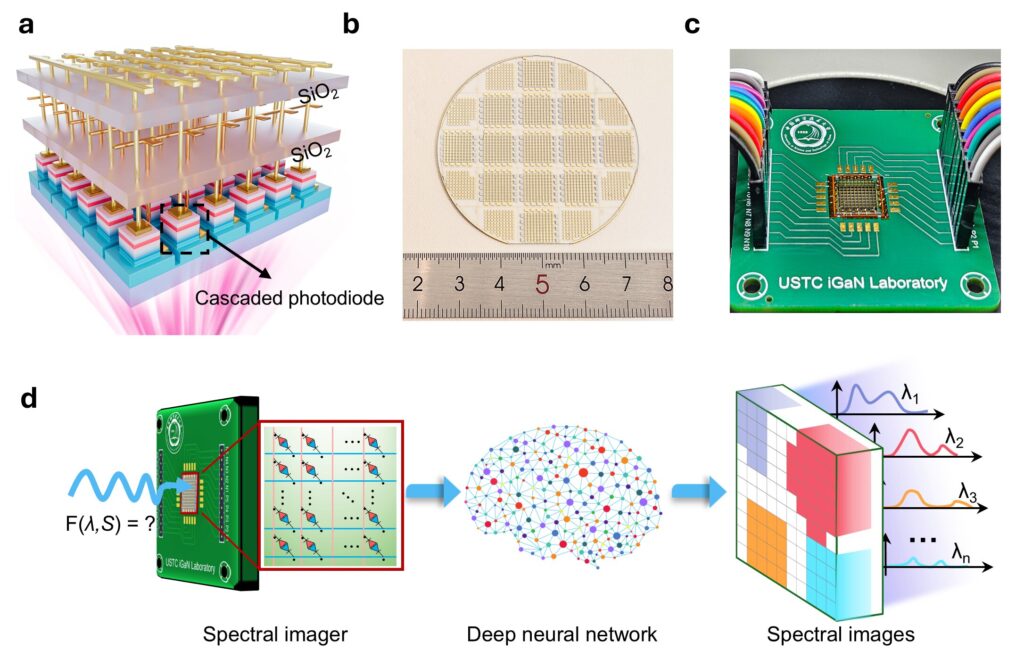
In a groundbreaking advancement for spectral imaging technology, the iGaN Laboratory at the University of Science and Technology of China (USTC), led by Professor Haiding Sun, in collaboration with Wuhan University’s academician Sheng Liu, has developed the world’s first miniaturized ultraviolet (UV) spectrometer chip. This innovation, which integrates a novel gallium nitride (GaN) cascaded photodiode architecture with deep neural network (DNN) algorithms, was published in Nature Photonics on September 26, 2025.
The newly developed chip achieves high-precision spectral detection and high-resolution multispectral imaging, setting a new world record for response speed on the nanosecond scale. This advancement marks a significant leap forward in the field of spectral imaging, which captures both spectral and spatial information to precisely measure and identify complex environments and targets.
Revolutionizing Spectral Imaging
Spectral imaging has vast applications ranging from material analysis and environmental monitoring to satellite remote sensing and deep-space exploration. Traditionally, spectral imagers have relied on bulky, complex, and costly systems involving diffraction gratings and mechanical scanning. This has limited their portability and integration, especially in deep-UV/UV applications crucial for biopharmaceuticals and organic molecule detection.
The iGaN Laboratory’s solution involves a GaN-based cascaded photodiode architecture, which can be fabricated as arrays on 2-inch wafers and integrated through bonding. This design enables a voltage-tunable bidirectional spectral response, with the DNN algorithms allowing for the accurate reconstruction of unknown spectra. Operating across 250–365 nm, the chip achieves approximately 0.62 nm resolution and a response time of less than 10 nanoseconds, the fastest among all reported miniaturized spectrometers.
Practical Applications and Demonstrations
Utilizing this chip, the research team successfully conducted spatially resolved, single-shot imaging of organic liquid droplets, including olive oil, peanut oil, animal fat, and milk. Each pixel recorded wavelength-dependent photocurrent signals, generating a comprehensive three-dimensional dataset. After spectral reconstruction via neural networks, high-resolution spectral images were obtained, clearly delineating the distinct UV absorption characteristics and spatial distributions of various organic substances. These demonstrations underscore the chip’s potential in molecular recognition and food safety testing.
Future Prospects and Industrial Impact
This pioneering work introduces a new paradigm for miniaturized spectrometer chips, utilizing wide-bandgap nitride semiconductors as a spectral chip platform for the first time. Looking ahead, the operational range of this chip architecture could be extended from UV to visible and even infrared by adjusting material composition and doping or introducing other compound semiconductors such as CdS, ZnO, GaAs, and InP.
The fabrication process aligns with large-scale semiconductor manufacturing, potentially reducing chip dimensions to submicron or nanometer scales, thereby enhancing resolution while lowering costs. The team anticipates that production costs could decrease to as little as one-hundredth of conventional spectrometers. This breakthrough is poised to drive a new wave of industrial advancement in spectral imaging, much like silicon-based CCD/CMOS technology facilitated the widespread adoption of digital cameras.
Collaborative Efforts and Acknowledgments
The co-first authors of this work are Dr. Huabin Yu, Dr. Muhammad Hunain Memon, Mr. Zhixiang Gao, and Mr. Mingjia Yao. Professor Haiding Sun of USTC is the sole corresponding author, with significant support and guidance from Academician Sheng Liu, Professor Zongyin Yang, and Professor Tawfique Hasan.
This story is part of Science X Dialog, a platform where researchers can report findings from their published research articles. For more information about Science X Dialog and participation details, visit the official page.
Dr. Muhammad Hunain Memon is currently a postdoctoral researcher at the School of Microelectronics, University of Science and Technology of China (USTC).







